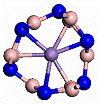Department of Physics and Astronomy: Publications and Other Research

Stephen Ducharme Publications
Document Type
Article
Date of this Version
11-2008
Abstract
Self-organizing nanostructures are ubiquitous in both natural and synthetic materials. They are not only appealing scientifically, by revealing the intrinsic atomic and molecular interactions that might be difficult to detect otherwise, but may also hold the key for the development of novel functional structures and devices. For their technological potential to be fully realized, the size, morphology, and distribution of the self-organizing nanostructures must be regulated. In this paper, we investigate the principles under which the self-organizing nanostructures can be regulated via external mechanisms. Using nanomesa and nanowell formation in polyvinylidene fluoride trifluoroethylene copolymer film as an example, we demonstrate that the external mechanism, if appropriately applied, can not only change the structure stability and trigger pattern formation in the otherwise stable films where self-organizing nanostructure is impossible to form, but can also regulate the size, morphology, and distribution of self-organizing nanostructures in a very effective manner.While the analysis is carried out for a particular system, the principles should be applicable for a wide range of self-organizing materials and structures.


Comments
Published in JOURNAL OF APPLIED PHYSICS 104, 094302 (2008). DOI: 10.1063/1.3000658 Copyright © 2008 American Institute of Physics. Used by permission. Online from the publisher at http://dx.doi.org/10.1063/1.3000658 (this link requires subscription).